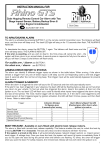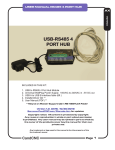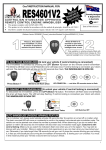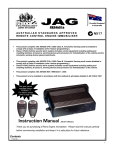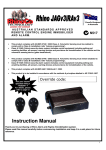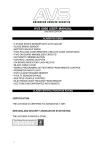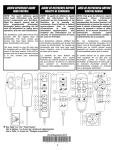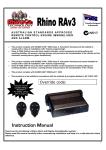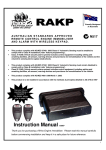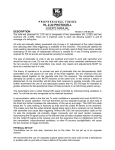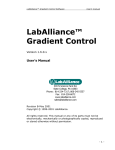Download GTR User Manual - RhinoCo Technology
Transcript
INSTRUCTION MANUAL FOR Remote Control Car Alarm with Impact Sensor, Mini-Battery Backup Siren & Engine Immobiliser SYDNEY / AUSTRALIA Build Date: A.C.N 001 621 610 TO ARM/DISARM ALARM The alarm is activated by pressing BUTTON 1 on the remote control transmitter once. The blinkers will flash once, and the siren will beep once. The dash LED-light will stay on for 10 seconds then flash, THE ALARM IS NOW ON. To deactivate the alarm, press the BUTTON 1 again. The blinkers will flash twice and the siren will beep twice. THE ALARM IS NOW OFF. If the siren is sounding, and you wish to disarm, the first press will cancel the siren the system will then return to an armed state. A second press is required to fully turn the alarm off (you will hear 2 beeps & the blinkers will flash twice) . 1 2 BOOT RELEASE - Available on cars fitted with electric boot release motors. The alarm is fitted with remote boot release capability. This feature enables the user to unlock the boot by pressing BUTTON 2 for 2 seconds. The boot will unlock and the indicators will flash 14 times. For safety reasons, the remote boot release will not work when the ignition is on. DOOR AJAR WARNING & BYPASS When arming, if the alarm senses that a door has been left open, 4 seconds after the normal arming beep, the siren will beep a further 5 times. The door trigger input will be automatically bypassed to prevent false alarms. ALARM TRIGGER & MEMORY When the alarm is triggered the siren will sound for 30 seconds and then will automatically rearm. If the alarm has been triggered in your absence, the dash LED will be flashing twice as fast as normal when you return to your vehicle. EMERGENCY PANIC BUTTON The panic feature is activated by pressing & holding BUTTON 1 on the remote control transmitter for 2 seconds. If disarmed, the alarm system will arm first (i.e. lock doors) then the siren will sound & the blinkers will flash for 30 seconds. If armed, the alarm system will stay armed (i.e. the doors will not unlock) & the siren will sound & blinkers flash for 30 seconds. To cancel “panic”, follow disarm procedure as desribed on page 1. NOTE: Panic does not work when the ignition is on by requirement of Australian Law (EPA-Environmental Protection Authority). 1 PROGRAMMABLE FEATURES: The features outlined below are the most popular that can be turned on or off to suit your requirements. Please refer to the section is this manual marked “Rhino Programmable Features” for full details. PASSIVE ARMING: The alarm can automatically arm itself 30 seconds after you leave your vehicle provided that the ignition is turned off, and that at least one door has been opened and closed ie. the owner has parked and has exited the vehicle. This feature will not lock the vehicle where central locking is connected. AUTOMATIC RE-ARM : This feature prevents accidental disarming by the owner ie. the owner turns the alarm off but is then distracted and forgets that they have deactivated the system. If a door is not opened, or the ignition is not turned on within 60 seconds from when the system is turned off by the remote, the system will re-arm, and if central locking is connected, it will re-lock the vehicle. SILENT ARM/DISARM : This feature when turned on, stops the siren from beeping for arm & disarm confirmation i.e. only the blinkers will flash. LEARNING NEW REMOTES (Up to 3 remotes can be used with this alarm system) Before entering this mode,make sure you have all remotes present that you wish yo utilise with this alarm system, as the alarm automatically erases all remotes when you enter this mode. A. Arm then Disarm the alarm system. While the system is disarmed, open and close your drivers door (get inside the vehicle), making sure the interior light is coming on as you open the door. B. Within 30 seconds, turn the car ignition key from the off position to the ignition on position 8 times. C. 10 seconds later, the blinkers will flash 8 times to confirm that you have entered the remote learning mode. Repeat steps A & B if you do not receive the flashes. D. Now press & hold Button 1 on the new remote you wish to learn in. The siren will beep once to confirm the code has been learnt. Repeat this step for up to 3 remotes. You can use this process to delete lost remote controls by learning in the same remotes in succession to replace each of the 3 memory locations so that the old remote code/s are erased. E. The system will automatically exit the learning mode 20 seconds after the last press of a remote. 2 STANDARD SYSTEM FEATURES 2 x Remote Controls Smart Code Learning Technology 1 Point Engine Immobilisation (Onboard Relay) Can Protect Doors, Boot, Bonnet Car Body Impact Sensor Mini Backup Battery Siren Flashes Indicators Flashing Red Dash Light Central Locking Control for Keyless Entry Arm/Disarm Beep Emergency Panic via Remote Car Finder Function Current (Voltage Drop) Sensing Automatic Siren Reset (30 seconds) Security Override Mode Boot Release via Remote (where fitted) Split System - Separate Siren & Brain SELECTABLE SYSTEM FEATURES Passive Arming Auto Rearm & Relock Audible or Quiet Arm/Disarm Current Sensing (Voltage Drop) Circuit Central Locking Output Time Selectable - 0.8 or 5 Seconds OPTIONAL ACCESSORIES: Automatic Electric Window Lift Paging System Ultrasonic Sensors Microwave Sensor (Part No. GLU400 - Closes 2 Windows) (Part No. APAGER) (Part No. UD6) (Part No. UD5) 3 Your Rhino Security system incorporates the latest in high security & convenience features. It is possible to customise your security system so that it suits your requirements perfectly. Detailed below is the full list of programmable features that can either be turned on or turned off. We have set at the factory, the most common configuration chosen and these settings are listed in the REGISTER Settings listed below. Once the desired features have been selected, the selection is permanently retained in memory, even if power is removed. To turn on or turn off any feature use the following procedure: eg to enable silent arming. 1. Arm then disarm the alarm system. 2. Within 20 seconds of disarming, turn the ignition key to on. 3. Press button 1 on the remote control (immediately after turning the ignition on) an equal number of times to the selected feature’s code no. (eg 10 times for Audible arm/disarm). Leave a 0.5 sec. gap between each press. The siren will chirp to confirm each press. 4. Immediately turn the ignition to off after the last press. 5. The system will now confirm whether the feature has been turned on or off via visual readout. One flash of the indicators means the feature is on. Two flashes means the feature has been turned off. PROGRAMMABLE FEATURE Press Remote This Many Times Indication INITIAL FACTORY SETTING DESCRIPTION Voltage Drop (Current) Sensing 6 1 Flash On 2 Flash Off OFF If deactivated, this feature will prevent the alarm triggering via sensing a drop in voltage in the vehicle’s electrical system. This may be necessary where engine thermo fans cut in automatically or there are other accessories active even when the ignition is turned off eg fridges, car phones. Passive Arming 7 1 Flash On 2 Flash Off OFF The alarm can automatically arm itself 30 seconds after you leave your vehicle provided that the ignition is turned off, and that at least one door has been opened and closed ie. the owner has parked and has exited the vehicle. This feature will not lock the vehicle where central locking is connected. Auto Re-arm 8 1 Flash On 2 Flash Off OFF If system is disarmed and a door is not opened, or the ignition turned on within 60 seconds, the system will rearm & relock (where central locking is connected). Central Closure 9 1 Flash 0.8 2 Flash 5 sec 0.8 sec You can select the lock & unlock outputs to become a 5 second negative pulse instead of 0.8 seconds. This feature is for certain vehicles with vacuum central locking or those with a central closure wire (some BMW, Mercedes) ie doors lock, electric windows wind up, sunroof closes automatically. Audible Arm/Disarm 10 1 Flash On 2 Flash Off ON This feature when turned off, stops the siren from beeping for arm & disarm confirmation i.e. only the blinkers will flash. Arming Delay 12 1 Flash On 15 – 45 You can increase the arming delay period 4 Adjustment & Door Ajar Warning 2 Flash Off Sec from the intital factory setting of 15 seconds up to 45 seconds. Door Ajar Warning: When the arming delay is set on 15 sec, if a car door is left open, when arming the siren will emit an error chirp after the normal arming beep. The alarm will also isolate the door trigger input to prevent trigger in case of faulty door pin switch. If arming delay is extended from 15 sec, this feature will not work. This may be necessary in vehicles that have an interior light delay. 5 TROUBLE SHOOTING GUIDE FOR RHINO GTR CAR ALARM. Golden Rule: Check Power & Earth Connections First. SYMPTOM SYSTEM BELIEVED TO BE “FALSE ALARMING” SYSTEM NOT WORKING AT ALL “OR” REMOTE CONTROLS ARE NOT ARMING OR DISARMING THE SYSTEM VEHICLE WILL NOT START “OR” VEHICLE ENGINE WILL NOT RUN SYSTEM ARMS WHILE THE ENGINE IS RUNNING ENGINE IMMOBILISATION DOES NOT OPERATE POSSIBLE CAUSE Power supply problem. REMEDY Check +12V & ground (earth) at the system module with a test lamp or multi-meter. Door or Bonnet Switches may be fautly. Check that switches operate correctly i.e. check interior light switches on every door & that the bonnet switch is making & breaking contact correctly. Impact Sensor sensitivity is set too high. Follow appropriate procedures as outlined on page 6 to adjust sensitivity. Check +12V & ground (earth) at the system module with a test lamp or multi-meter. Power supply problem. Grey wire from the system is connected to constant +12V. The Grey wire must be connected to the vehicle’s ignition wire (not constant +12V). System is armed. Press the remote until the blinkers flash twice, or two disarm beeps are heard. Grey wire from the system is connected to constant +12V. This wire must be connected to a +12V ignition switched lead, which does not drop to 0 Volts when the engine is being cranked. Immobilisation wiring is incorrect. Check the wiring on all points of immobilisation i.e. where starter and/or fuel circuits have been cut. The Grey wire is not connected to the ignition circuit. This wire must be connected to a +12V ignition switched lead, which does not drop to 0 Volts when the engine is being cranked. This wire must also be constant +12V when the engine is running. Bad earth. Check that the black wire is soldered to a good earth - a non-insulated metal part of the car body. The Grey wire is not connected to the correct point. Check that this wire is wired to the ignition circuit, not to the accessory circuit. Grey wire drops below +12V when the engine is being cranked. This wire must be connected to a +12V ignition switched lead, which does not drop to 0 Volts when the engine is being cranked. Power supply problem. Test for good +12V & earth at the system module. 11 SYMPTOM LOW VOLUME FROM SIREN NO SOUND FROM SIREN STRANGE NOISE FROM SIREN POSSIBLE CAUSE Power supply problem. REMEDY Test for good +12V & earth at the alarm module. Alarm main fuse has blown and the system is utilising the backup battery (only where a backup battery system is provided). Test for good +12V & earth at the alarm module. Check main power fuse. Power supply problem. Test for good +12V & earth at the alarm module. The siren speaker is damaged. Confirm that the alarm system is arming/disarming via flashing LED. Trigger alarm. Confirm other functions on alarm e.g. flashing indicators. If there is no sound from the siren, it most likely has a damaged speaker. Contact your Rhino Dealer. Bad earth. Check that the black wire is soldered to a good earth - a non-insulated metal part of the car body. If the siren makes unusual noise, especially if the car is stopped and alarm is deactivated, it is likely that the unit has suffered from water damage. Turn the alarm system completely off i.e. at keyswitch (where used). Contact your Rhino Dealer. If the siren makes a whining noise while the motor is running, it is likely that the unit is mounted too close to the vehicles ignition leads. VOLTAGE (CURRENT) SENSING DOES NOT OPERATE VOLTAGE DROP SENSING FALSE ALARMS AUXILIARY SENSOR FALSE ALARMS The main power wire (red) has been connected directly to the battery. Check that all connections to the siren are properly soldered. If this does no rectify the problem, move the siren to a different location. The red wire must be connected to constant +12V via the fuse box at the point where the interior light circuit is powered. Voltage sensing will not work if this procedure is not followed. Interior light is not operating correctly. The interior light must be set to come on when the vehicle’s doors are opened. Check the function of the interior light and switch. Car battery is faulty i.e. does not hold a proper charge. Change the car battery. Other appliances in the vehicle are drawing power after the alarm system has armed.i.e. engine cooling fans, car phone, car fridge etc. Auxiliary detectors are not adjusted correctly. Turn Voltage Drop Sensing off in Programmable Features (page 4). Adjust (reduce) the sensitivity of any Ultrasonic or Microwave sensor fitted with the alarm and test. 12 SYMPTOM CENTRAL LOCKING MOVES UP & DOWN WHILE DRIVING POSSIBLE CAUSE Central locking motors are not adjusted correctly. REMEDY Adjust the central locking motors so that they can travel their full displacement without excessive force. Bad earth to the alarm module . Check that the black wire is soldered to a good earth - a non-insulated metal part of the car body. Bad power connection to the central door locking motors. Usually a bad earth connection. Check for +12V & earth with a test light across the central locking power wires (normally black and red wires). Bad fuse. Check fuses and replace if necessary. NOTES FOR INSTALLATION: * Check the vehicles electrical system thoroughly before commencing installation. * The installation should be as well hidden as possible - to maximise the system security. * Solder all connections, and then insulate with insulation tape. * Use a multi - meter to verify any wires nature. IMPORTANT: If the installer does not have a concise knowledge of the vehicle’s electrical system, it is strongly advised not to aimlessly probe to find the necessary wires. Doing so may damage your vehicles electrical system. Consult with your vehicle’s manufacturer, or a qualified Auto Electrician. Rhino Alarms accepts no responsibility if an installer wires the product incorrectly or damages the vehicle during installation. www.rhino.com.au 13









